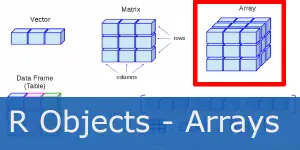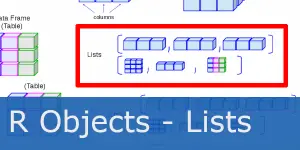
R Beginner Tutorial – Arrays
R Academy Menu ggplot2 basics: learn ggplot2 in 15 minutes!R Beginner TutorialR Beginner Tutorial – Basic SyntaxR Beginner Tutorial – R ObjectsR Beginner Tutorial –
Home » R Beginner Tutorial – Basic Syntax
This is part 2 of our R Beginner Tutorial. For part 1, head over to R Beginner tutorial.
Let’s look at basic syntax in R. We’ll learn how to use basic operators, functions, comments, R files and packages.
R knows the following arithmetic operators.
| Operator | Description |
| + | Addition |
| – | Subtraction |
| * | Multiplication |
| / | Division |
| ^ or ** | Exponent |
| %% | Modulus (Remainder from division) |
| %/% | Integer Division |
For example:
> x=10
> y=2
> x+y
[1] 12
> x-y
[1] 8
> x*2
[1] 20
> x/y
[1] 5
> x^y
[1] 100
> x**y
[1] 100
> x%%y
[1] 0
Similarly, we can use the following relational operators.
| Operator | Description |
| < | Less than |
| > | Greater than |
| <= | Less than or equal to |
| >= | Greater than or equal to |
| == | Equal to |
| != | Not equal to |
For example:
> x=10
> y=2
> x<y
[1] FALSE
> x>y
[1] TRUE
> x<=y
[1] FALSE
> x>=y
[1] TRUE
> x==y
[1] FALSE
> x!=y
[1] TRUE
Comments start with # symbol. For example:
#This is a commentPrinting is done by simply using the print() function.
> x = "I love R!"
> print(x)
[1] "I love R!"
There of course is an abundance of available math functions. Few examples are listed in the table below.
| Function | What It Does |
| abs(x) | Takes the absolute value of x |
| log(x,base=y) | Takes the logarithm of x with base y; if base is not specified, returns the natural logarithm |
| exp(x) | Returns the exponential of x |
| sqrt(x) | Returns the square root of x |
We use getwd() function to get a location of a working directory.
> getwd()
\\\\192.168.30.6/Home/gasperk/My Documents"We use setwd() function to set the location of working directory.
> setwd("C:/Users/gasperk")We use list.files() function to lčist all the files in a directory.
> list.files()
[1] "AppData"
[2] "Application Data"
[3] "ChannelData.xlsx"
[4] "Contacts"
[5] "Cookies"
[6] "Desktop"
…
We can find help for any function by typing help(function_name). For example, help for log function:
> help(log)
In conclusion, this sums up all the R syntax basics. Tune in next week to discuss data structures!
If you’re already running late, we recommend you head over to our two R crash courses:
For even more amazing tips check out our awesome ExcelOlympics YouTube channel!




